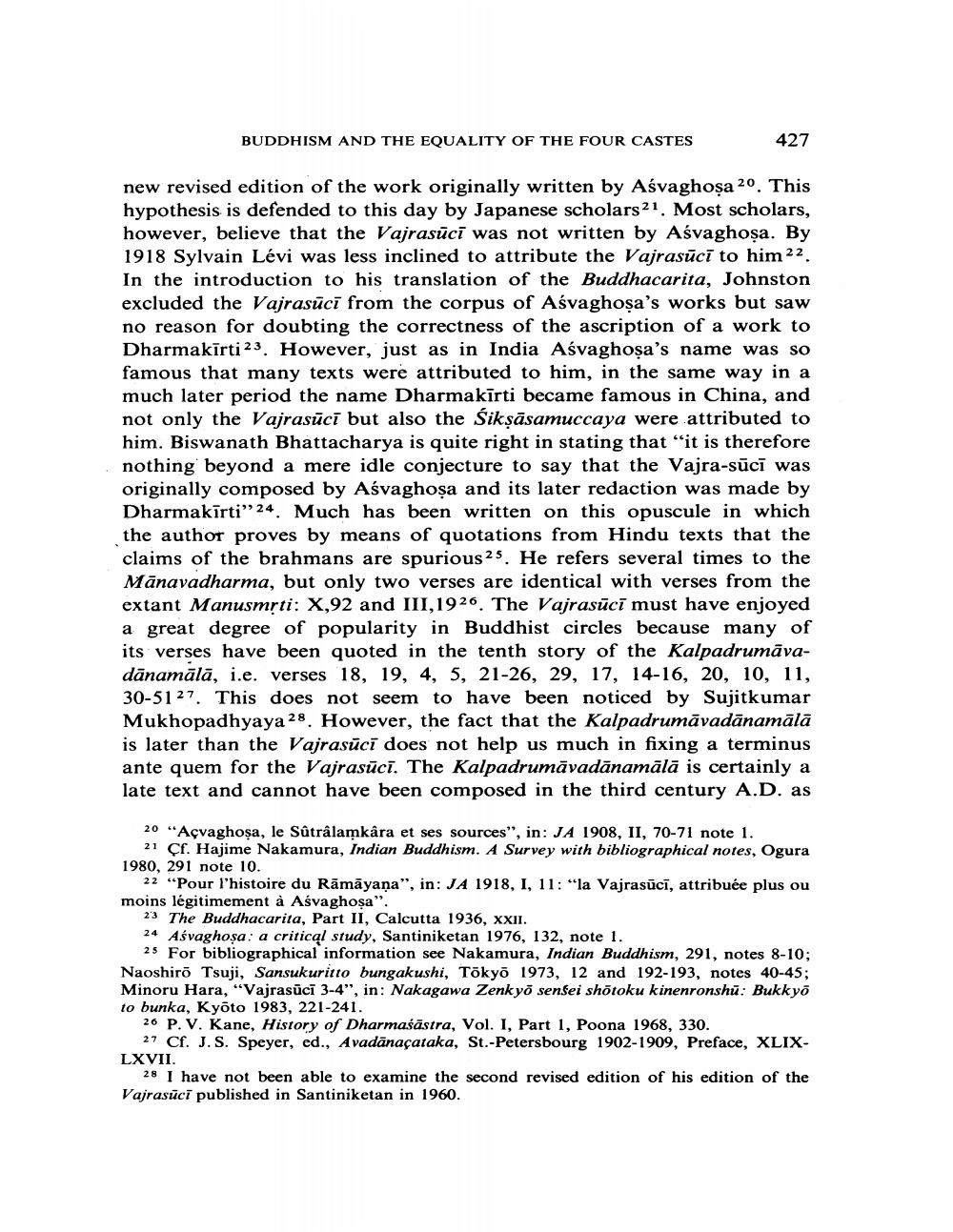Book Title: Buddhism And Equality Of Four Castes Author(s): J W De Jong Publisher: J W De Jong View full book textPage 5
________________ BUDDHISM AND THE EQUALITY OF THE FOUR CASTES 427 new revised edition of the work originally written by Asvaghosa 20. This hypothesis is defended to this day by Japanese scholars11. Most scholars, however, believe that the Vajrasūcī was not written by Aśvaghosa. By 1918 Sylvain Lévi was less inclined to attribute the Vajrasūcī to him 22. In the introduction to his translation of the Buddhacarita, Johnston excluded the Vajrasūcī from the corpus of Asvaghosa's works but saw no reason for doubting the correctness of the ascription of a work to Dharmakirti 23. However, just as in India Asvaghosa's name was so famous that many texts were attributed to him, in the same way in a much later period the name Dharmakirti became famous in China, and not only the Vajrasūcī but also the Sikṣāsamuccaya were attributed to him. Biswanath Bhattacharya is quite right in stating that "it is therefore nothing beyond a mere idle conjecture to say that the Vajra-sūcī was originally composed by Asvaghosa and its later redaction was made by Dharmakirti" 24. Much has been written on this opuscule in which the author proves by means of quotations from Hindu texts that the claims of the brahmans are spurious 25. He refers several times to the Manavadharma, but only two verses are identical with verses from the extant Manusmrti: X,92 and III, 1926, The Vajrasuci must have enjoyed a great degree of popularity in Buddhist circles because many of its verses have been quoted in the tenth story of the Kalpadrumāvadānamālā, i.e. verses 18, 19, 4, 5, 21-26, 29, 17, 14-16, 20, 10, 11, 30-5127. This does not seem to have been noticed by Sujitkumar Mukhopadhyaya 28. However, the fact that the Kalpadrumāvadānamālā is later than the Vajrasūcī does not help us much in fixing a terminus ante quem for the Vajrasüci. The Kalpadrumāvadānamālā is certainly a late text and cannot have been composed in the third century A.D. as 20 "Açvaghosa, le Sûtrâlamkâra et ses sources", in: JA 1908, II, 70-71 note 1. 21 Cf. Hajime Nakamura, Indian Buddhism. A Survey with bibliographical notes, Ogura 1980, 291 note 10. 22 "Pour l'histoire du Rāmāyaṇa", in: JA 1918, I, 11: “la Vajrasūcī, attribuée plus ou moins légitimement à Aśvaghosa". 23 The Buddhacarita, Part II, Calcutta 1936, XXII. 24 Asvaghosa: a critical study, Santiniketan 1976, 132, note 1. 25 For bibliographical information see Nakamura, Indian Buddhism, 291, notes 8-10; Naoshirō Tsuji, Sansukuritto bungakushi, Tokyo 1973, 12 and 192-193, notes 40-45; Minoru Hara, "Vajrasūcī 3-4", in: Nakagawa Zenkyō sensei shōtoku kinenronshū: Bukkyō to bunka, Kyoto 1983, 221-241. 26 P. V. Kane, History of Dharmasastra, Vol. I, Part 1, Poona 1968, 330. 27 Cf. J. S. Speyer, ed., Avadānaçataka, St.-Petersbourg 1902-1909, Preface, XLIXLXVII. 28 I have not been able to examine the second revised edition of his edition of the Vajrasūcī published in Santiniketan in 1960.Page Navigation
1 ... 3 4 5 6 7 8 9
